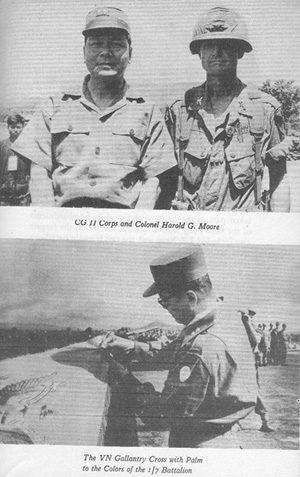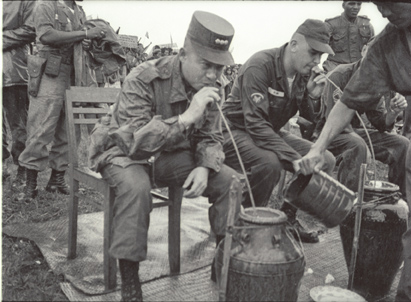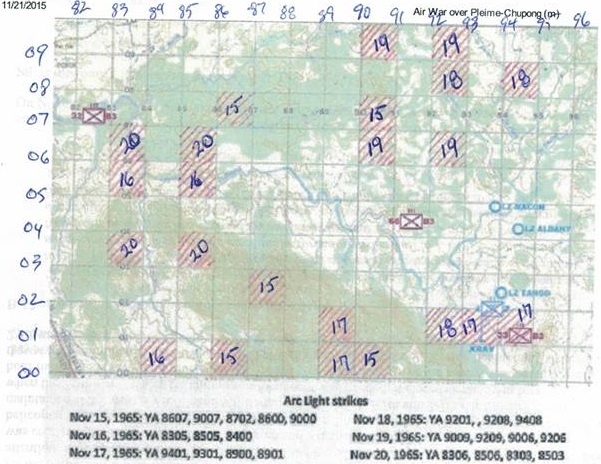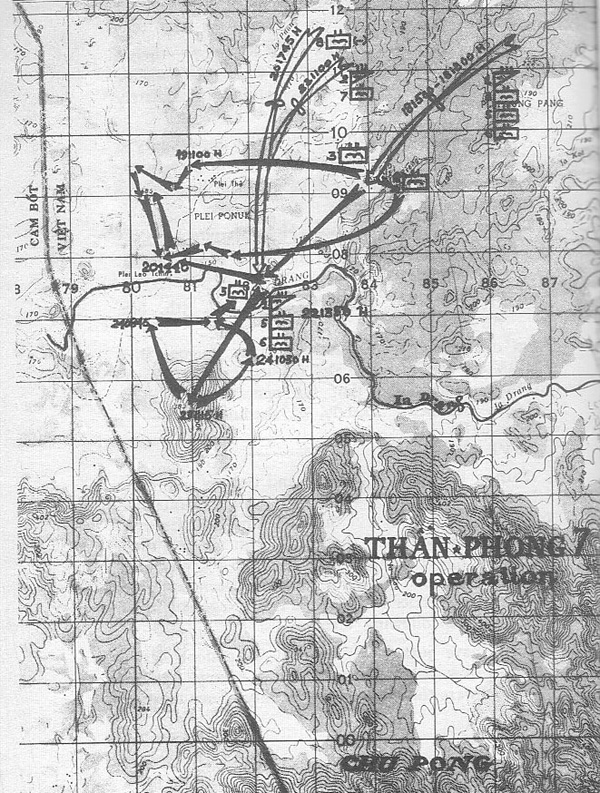
(Grab tail hit head)
Long Reach operation was conducted by the 1st Air Cavalry Division in the Chu Pong/Ia Drang complex, Central Highlands, Viet Nam, from 27 October to 26 November 1965. It is more well-known as the Pleiku campaign. It was executed in three operations: All the Way conducted by the 1st Brigade from 27 October to November 9; Silver Bayonet I by the 3rd Brigade from 9 to 18 November; and Silver Bayonet II by the 2nd Brigade from 18 to 26 November. The Battle of Ia Drang, which included the battles of LZ X-ray (14 to 16 November) and LZ Albany (17 to 18 November), occurred during the Silver Bayonet I operation.(1)
This was an ARVN-US joint operation in which the ARVN II Corps was in charge of the concepts of operation and intelligence and the US 1st Air Cavalry Division was in control of the troops and the logistics.(2)(3)

The II Corps Chief of Staff's operational concept was to use the B-52 airstrikes to destroy the three NVA 32nd, 33rd, and 66th Regiments at the moment they were staging a second attack of the Pleime camp in the Chu Pong massif areas.(4) The air force action was supported by the air cavalry ground force in fixing the enemy troops in becoming available targets for B-52 strikes. General Richard Knowles, 1st Air Cavalry Division Forward Command Post Commander, describes the tactical ground maneuvers of inserting the air cavalry troops at LZ X-Ray as "grab the tiger by its tail" and moving them to LZ Albany as "grab the tiger by its tail from another direction".(5)
Background
After failing to destroy the relief column of the besieged Pleime camp with the 32nd Regiment and overrunning the camp with the 32nd Regiment, the NVA B3 Field Front ordered both regiments to withdraw to their rear bases in the Chu Pong massif area. These two units were to rejoin with the 66th Regiment, and together all three would stage for a second attack of the Pleime camp with this time, the 66th as the main force reinforced by one 14.5mm twin-barrel anti-aircraft guns battalion and one 120mm mortars battalion.(6)
II Corps obtained this vital information through a unique intelligence source consisting of intercepts of radio communications between the Chinese advisors embedded in the NVA units at regimental level(7) and the Chinese advisors' headquarters established in Phnom Penn to assist the B3 Field Front in logistics.(8) The Chinese advisors conversed freely and openly in Mandarin,(9) not realizing that their conversations were monitored by the ARVN side. This source of intelligence was kept under wraps; both the NVA and the US sides thought it was "ARVN special agents".(10)(11) It allowed for the planning of every aspect of the operations on "current (real-time) intelligence" as well as for the successful scheduling of the five-day B-52 strikes.(12) Colonel Hieu stated that this "solid intelligence on the enemy situation had permitted the battle to develop to the maximum degree and scale and at the same token lead to the biggest victory ever achieved by the ARVN and its Allied."(13)

Usually, the planning of a B-52 airstrike was assumed by the J2 and J3 Chiefs of the MACV with the J2 Chief studying and selecting existing targets consisting of rear bases of supplies and/or troops concentration based on intelligence. In the case of Long Reach operation, enemy troops were lured into becoming targets by II Corps based on its unique intelligence source. The execution involved the following three phases: setting up, fixing, and striking.
On 26 October 1965, II Corps requested the help of American troops to conduct an exploitation operation after the victory achieved at Pleime. The entire 1st Air Cavalry Division was assigned to reinforce the II Corps force. The joint ARVN-US operation was named Long Reach (Trường Chinh in Vietnamese) and conducted under a special operational protocol consisting of "shared intelligence and concept of operations, separate TAOR, command, deployment of forces, conduct of activities and reserve."(2) An Air Cavalry Tactical Command Post, under the leadership of Brigadier General Richard Knowles, was established next to II Corps headquarters.(14) The 1st Air Cavalry Division TAOR was expanded to the entire Chu Pong-Ia Drang complex, except the Pleime camp vicinity, which remained under the ARVN responsibility to make it appear weak to entice the enemy for attempting a second attack.(15)
Execution
Long Reach was launched on 27 October with the participation of the 1st Air Cavalry Brigade.
= Operation All the Way (27 October to 9 November)
Its mission was to herd the withdrawing troops of the 32nd and 33rd back to their rear bases in the Chu Pong massif where they would join forces with the 66th Regiment.
On 27 October, Eagle Flights from the Air Cavalry Division went into action. They flew over the area in search of the enemy. When found, these units were dealt with. These tactics compelled the enemy to move continuously.(16) By the end of the day, the lead elements of the 33rd Regiment reached its forward assembly area, the village of KRO. On 28 October, the entire 32nd Regiment closed in at the north bank of the Ia Drang river. On 31 October, the enemy units continued to disintegrate and fragmented into small parties while heading to its rear base at the foot of Chu Pong massif. On 1 November, the Air Cavalry troops discovered and destroyed a VC field hospital; and the 33rd Regiment headquarters had reached the base at Anta village, but the bulk of the regiment was still strung out between Pleime and Chu Pong. On 2 November, the 66th Regiment began moving into assembly areas in the Chu Pong-Ia Drang area. On 3 November, the Air Cavalry troops ambushed the 8th Battalion of the newly-infiltrated 66th Regiment while the 33rd Regiment was still trying to pull its bruised and battered tail into the Chu Pong sanctuary. On 4 November, the 33d Regiment moved out of its base at Hill 732 to take up positions from Hill 732, down to the north bank of the Ia Meur while its fragmented bits were still making their way in a westward direction. The battalion that had acted as rear guard, starting later and moving more slowly than the rest was still east of main Cavalry positions. On 6 November, the 66th Regiment continued to close into assembly areas and the 33d Regiment waited for its shattered forces to rejoin the parent unit. The 32d Regiment and Field Front, meanwhile, remained north of the Ia Drang and adjacent to the Cambodian frontier. On 7 November, the depleted 33d Regiment waited for its stragglers to come in. On 8 November, only fragmented units and stragglers remained east of the Chu Pong-Ia Drang complex. On 9 November, the Field Front headquarters was at the north of the Ia Drang and the 33d Regiment gathered in the last of its organic units.(17)
All these herding efforts were accomplished by the Eagles flights. During this phase, the Air Cavalry infantrymen of the 2/12, 1/8, 1/12 and 2/8 Battalions have had few - nine - engagements with the enemy.(18)
The herding phase ended. However, although the enemy units had gathered in the Chu Pong massif area, they were still widely scattered in a defensive posture as to render B-52 airstrike futile. Next came the phase of enticing the enemy units into getting closer together and become available targets for B-52 airstrikes.
= Operation Silver Bayonet I (9 to 18 November)
On 9 November, the 3rd Air Cavalry Brigade replaced the 1st Air Cavalry Brigade and conducted Operation Silver Bayonet I. Its mission was to set up targets for B-52 airstrikes.
The 3rd Air Cavalry Brigade was ordered to switch the operational direction from west to east as if it had lost track of the enemy positions. The B3 Field Front felt for the subterfuge and decided to commence staging for the second attack of the Pleime camp. On 11 November, its three Regiments were ordered to go in assembly areas for reorganization, re-equipment and rehearsals in preparation for the attack set for 16 November.(19) These troop concentrations in assembly areas became available for B-52 airstrike. The J3 Chief/MACV was notified to set the B-52 airstrike in motion. The first wave of bombs would be dropped at a location about 7 and a half kilometers west of LZ X-Ray and the time over target (TOT) was set for 16 hours of 15 November.(20) On 12 November, the 1/7 Air Cavalry Battalion was ordered to get ready to be inserted at Chu Pong massif as a diversionary maneuver.(21) On 13 November, as some recon elements and transportation units of the NVA B3 Field Front had already moved out of their assembly areas, the 1/7 Air Cavalry Battalion was ordered to be inserted at the eastern foot of Chu Pong massif and to conduct an operation to at least 15 November(22) with the intention to lure the B3 Field Front to delay the movement of troops out of the assembly areas to a later date than the TOT.(23) On 14 November, some assault elements of the NVA B3 Field Front started moving out of their assembly areas.(24) At 10:48 hours, the lead elements of the 1/7 Air Cavalry arrived at the LZ X-Ray following a 30-minute bombardment of artillery, aerial rockets, and airstrikes. The insertion point was located about 200 meters from the position of the 9th Battalion belonging to the NVA 66th Regiment. The B3 Field Front took the bait and decided to attack the new threat with two battalions - the 7th and the 9th belonging to the 66th Regiment - while ordering the 32nd and the 33rd to hold their positions in their respective assembly areas.(25) The 3rd Air Cavalry Brigade reacted by sending in a reinforcement comprising the 2/7th and the 2/5th Air Cavalry Battalions, which closed in at 9:10 hours and at 12:05 hours on 15 November respectively.(26) The safety of the 1/7th Air Cavalry Battalion was further beefed up by a "ring of steel" of artillery and by around the clock air attacks on every route in and out of the landing zone to interdict the 32nd and 33rd Regiments from joining in the fight.(27) The B-52 airstrike entered in action at 16:00 hours and carpet-bombed the positions of the 33rd and 32nd Regiments for the 15 and 16 November. The 1/7th Air Cavalry Battalion left LZ X-Ray at noon of 16 November, replaced by the 2/7th and the 2/5th. In the morning of 17 November, these two battalions abandoned LZ X-Ray by foot toward LZ Albany and LZ Columbus respectively in a tactical maneuver to "grab the tiger by its tail in another direction"(5) allowing to carpet bombing the positions of units of the 66th Regiment remaining in the vicinity of LZ X-Ray.(28) The Air Cavalry troops suffered heavy casualties at LZ X-Ray and LZ Albany because the enemy tactics had relied mostly on "human waves".(29)

The B-52 airstrike continued for another two days all over the Chu Pong-Ia Drang complex from west to east, rendering the heavy canopy area ineffective for concealment and cover. II Corps intelligence estimated the action of the B-52 airstrikes had rendered 2/3 of the enemy force ineffective. The remnants of the NVA forces' escape route to Cambodia was reduced to a narrow corridor along the Ia Drang.(30)
= Operation Silver Bayonet II/Operation Thần Phong (18 to 26 November
On 18 November, the 2nd Air Cavalry Brigade was ordered to move up to LZ Crooks to "grab the tiger by its tail from another direction"(5) to allow the ARVN Airborne Brigade to destroy the two remaining battalions belonging to the 32nd Regiment - 334th and 634th. The 2nd Air Cavalry Brigade continued to exert pressure from east to west and established an artillery firepower base at LZ Crooks manned by the 2/17 Arty and secured by the 2/5 Air Cavalry Battalion to give support to the ARVN paratroopers' Thần Phong operation.(30)

The Airborne Brigade destroyed three training centers, a cache of equipment and 75 houses. They also killed 265 VC and captured 58 weapons in two ambushes on 20 and 24 November. On 26 November, as no more contacts were made with the enemy who had escaped back to the Cambodian sanctuary, the ARVN Airborne Brigade and 1st Air Cavalry Division withdrew from the area of operations. (31)(32)
- (1) Kinnard, William (1966), Pleiku Campaign, After Action Report, p.1
- (2) Vinh Loc (1966), Why Pleime, Viet Nam: Information Printing Office, p.119
- (3) Knowles, Richard (1983), LZ X-Ray Battle, p.7
- (4) McChristian, J.A. (1966), Intelligence Aspects of Pleime/Chupong Campaign, J2/MACV, p.6
- (5) Knowles, p.6
- (6) Vinh Loc, p.80
- (7) Mohr, Charles, Three Prisoners Tell Of Aid From China North Vietnamese Also Say Cambodians Helped Them, The New York Times, (16 November 1965): Captured North Vietnamese soldiers said today that their units had received assistance from Cambodian "militiamen" during their infiltration into South Vietnam and that each infiltrated regiment had one Chinese Communist adviser.
- (8) Vĩnh Lộc (1966), Pleime Trận Chiến Lịch Sử, Viet Nam: Bộ Thông Tin, p.124
- (9) Moore, Harold G. & Joseph L. Galloway (1992), We Were Soldiers Once ... and Young — Ia Drang: the battle that changed the war in Vietnam, New York, New York: Harper Perennial, ISBN 0-06-097576-8, p.64
- (10) Kinnard, p.46
- (11) Coleman, J.D. (1988), Pleiku, The Dawn of Helicopter Warfare in Vietnam, New York: St.Martin's Press, p.119
- (12) McChristian, p.2
- (13) Vĩnh Lộc, p.94
- (14) Kinnard, p.ii
- (15) G3 Journal/I Field Force Vietnam, November 14–26, 1965 [1], [2], [3], [4] (document stored at the National Archive, College Park, Maryland), 10/30/65 entry
- (16) Vinh Loc, p.76
- (17) McChristian, pp.16-40
- (18) Coleman, p.189
- (19) Kinnard, pp.67-76
- (20) Kinnard, p.89
- (21) Coleman, p.196
- (22) Coleman, p.199
- (23) Kinnard, p.82
- (24) Kinnard, p.85
- (25) Nguyễn Hữu An (2005), Chiến Trường Mới, Hồi Ức, Hŕ Nội: Nhŕ xuất bản Quân đội Nhân dân, p.34
- (26) Vinh Loc, p.88
- (27) Knowles, p.4
- (28) Kinnard, p.94
- (29) Vinh Loc, p.92
- (30) Vinh Loc, p.97
- (31) Vinh Loc, p.103
- (32) Kinnard, p.120
Nguyen Van Tin
13 October 2017
- Operation Pleime-Chupong B-52 Strike?
- The Use of B-52 Strike in Ia Drang Campaign, General Westmoreland’s Best Kept Military Secret
- Air War Over Pleime-Chupong
- Arc Light over Chu Pong Operation
- Catching a Thief Tactic in Pleime Campaign
- Pleime/Chupong Campaign Destroying B3 Field Front Base
- The Uniqueness in Pleime Counteroffensive Operational Concept
- Pleime Counteroffensive into Chupong Iadrang Complex
- The Unfolding of Strategic and Tactical Moves of Pleime Campaign
- Battle of Pleime
- The Truth about the Pleime Battle
- Intelligence Gathering at Ia Drang
- Intelligence, the Key Factor in the Pleime Campaign's Victory
- Roll Call of Combatants at Pleime-Chupong-Iadrang Battlefront
- "Victory at Pleime" ?
- Tactical Moves in Pleime Battle
- Kung Fu Tactics at Pleime Campaign
- Various Diversionary Moves in Support of Arc Lite Strike in Pleime Counteroffensive
- What if there was no master plan for Pleime Counteroffensive?
- Pleime/Chupong Campaign Destroying B3 Field Front Base
- A Few Things You Should Know about Pleime-Iadrang Campaign
- Things the VC Don't Want People To Know at Pleime Battle
- Reviewing "Why Pleime"
- Review of "Intelligence Aspects at Pleime_Chupong Campaign"
- Perplexing Maneuvers at Pleime-Chupong-Iadrang You Might Be Attempted to Question
- A Bird’s-Eye-View of Pleime Campaign
- Operation Dan Thang 21
- US Air Force’s Roles in Pleime Campaign
- Arc Lite Operation Planning and Execution in Pleime Offensive
- A Doctrinal Lesson on the Use of Arc Lite in Pleime Counteroffensive
- Command and Control of Arc Light Strike at Chupong-Iadrang
- A Military Genius in Action at Pleime-Chupong-Iadrang Battlefront
- Command and Control Skills in Pleime Campaign
- Behind-the-scenes Activities at Various Allied Headquarters During Pleime Campaign
- The Two Principals Players Of Pleime Chess Game
- Pleime Battle's Diary
- Pleime Campaign and Pleiku Campaign
- A New Look at Ia Drang
- Operation Long Reach
- LZ X-Ray Battle (General Knowles)
- My Contributions to the Battle of Ia Drang in Wikipedia
- Operation LZ X-Ray
- Colonel Hal Moore’s Self-Aggrandizement in “We Were Soldiers Once ... and Young”
- Colonel Hal Moore Misunderstood his Mission at the Ia Drang Battle
- What Historians Failed to Tell About the Battle at LZ X-Ray
- Hal Moore and 1/7th Air Cavalry Battalion's Real Mission at LZ X-Ray
- Two Different Narrations of LZ X-Ray Battle by II Corps
- Ia Drang Valley Battle? Which One?
- LTC Hal Moore Summoned to a Woodshed Session?
- Colonel Hieu's Operational Concept for LZ X-Ray
- LZ Albany Battle - Chinese Advisors' Perspective
- A Puzzling Air Assault Performed by 1/7 Air Cavalry at LZ X-Ray
- Two Different Narrations of Than Phong 7 Operation by II Corps
- General Schwarzkopf's Naďveté In Ia Drang Battle
- Venturing into Lion's Den in Ia Drang Valley
- American Perspective of Pleime Battle
- General Kinnard's Naďveté in Pleime Campaign
- "No Time for Reflection at Ia Drang" ?
- Pleime Campaign or Pleime-Ia Drang Campaign?
- A Critique of General Bui Nam Ha's Opinions about Plâyme Campaign
- Commenting on General Nguyen Huu An's Account of Plâyme Campaign
- Crushing the American Troops in Western Highlands or in Danang?
- What Really Happened at Ia Drang Battle
- Case Study of a Typical Misinterpretation of Ia Drang Battle
- Ia Drang Battle Revisited
Documents
- Why Pleime
- Pleime, Trận Chię́n Lịch Sử
- Pleime Battle Viewed From G3/I Field Force Vietnam
- Long Reach Operation Viewed From G3/I Field Force Vietnam
- LZ X-Ray Battle and LZ Albany Battle Viewed From G3/I Field Force Vietnam
- Than Phong 7 Operation Viewed From G3/I Field Force Vietnam
- Arc Light Strike at Chupong-Iadrang Viewed From G3/IFFV
- Pleiku Campaign
- Intelligence Aspects at Pleime_Chupong Campaign
- Excerpts of General Westmorland’s History Notes re: Pleime-Chupong-Iadrang Campaign
- LZ X-Ray Battle (General Knowles)
- LZ X-Ray After Action Report - LTC Hal Moore and Colonel Hieu
- Than Phong 7
- 52nd Combat Aviation Battalion in Support of Pleime Campaign
- CIDG in Camp Defense (Plei Me)
- Viet Cong Requested Red China's Aid
- Battle of Duc Co
- NVA Colonel Ha Vi Tung at Pleime-LZ Xray-LZ Albany
- The Fog of War: The Vietnamese View of the Ia Drang Battle
- No Time for Reflection: Moore at Ia Drang
- 1st US Cavalry Division Gives Support in the Battle at Plei Me
- Plei Me Fight Stands As War Turning Point
- Plei Me Battle
- Seven Days of Zap
- Pleime Through New York Times' View
- First Engagement With American Troops at Pleime-Iadrang
- Pleime Campaign
- Crushing the American Troops in Central Highlands
- NVA 66th Regiment in Pleime-Ia Drang Campaign
- The Political Commissar at the First Battle Against the Americans in Central Highlands